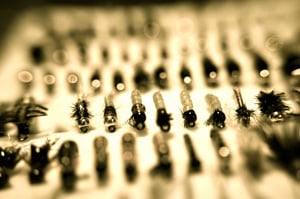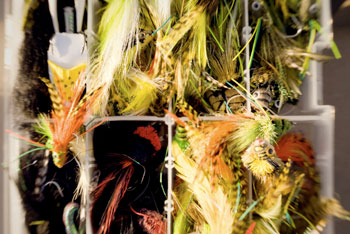Interview: James R. Babb
MIDCURRENT SAT DOWN with James Babb, the longtime editor of Gray’s Sporting Journal and author of Crosscurrents: A Fly Fisher’s Progress; River Music: A Fly Fisher’s Four Seasons; and Fly-Fishin’ Fool: The Adventures, Misadventures, and Outright Idiocies of a Compulsive Angler, to discuss friends, family, fly patterns, fly tying, and a life spent on the water.

Steelhead Flies and Fashion
I had a box of stupid looking steelhead flies, which I eventually gave away. We believe that flies are meant to imitate life and steelhead flies are essentially meant to imitate a Barbie Doll’s fashion accessories—especially if you appreciate purple Easter bunnies with black feather boas and red clown noses.
Losing Fly Boxes in the River
It’s just horrifying, particularly if you tie your own, because I don’t tie for any sense of artistic creation. I tie because I can’t afford to buy new flies very often, so you know it’s a real bummer when you get back to the car and start slapping your vest pocket and saying, “Oh shit.” You can always get another fly rod, but I mean who is going to sit down and tie all those size 20 midges you can no longer see well enough to tie?
Emergers in the Wind
Jim Lepage and I were fishing up on the East Censored River eight or ten years ago, and there was a particular tiny emerger they were hitting. We were towing them along the bottom, tethered to a double tungsten Rock Worm to get them down. They weren’t really eating anything else, so Jim tied a bunch in the motel room, while I lingered encouragingly to one side and gave him a lot of moral support. We went back out to the river the next day with all these newly tied pale emergers, and it was a typical October day in Maine—snowing sideways and blowing 50 knots. He opened up his fly box and a gust of wind took two-dozen flies straight up into the air. And they went away in a little tornado. There were rises all the way down the river… at least he had the satisfaction of knowing they worked.
What’s to Like About Swinging Flies
 Small stream pocket water. Photo by Tim Romano
Small stream pocket water. Photo by Tim RomanoMy friend Rick Blackburn, who I grew up with down in East Tennessee and now lives in Gallatin Gateway, and I were fishing below Three Dollar Bridge on the Madison River late one evening, and it was one of those nights where the invisible caddis are hatching. And the people who fish for invisible caddis were there fishing for them. You know the kind—they’ve got monoculars glued to their glasses, fish ten-foot three-weights, and they’ve tied little emergers that match everything down to the assholes and elbows. And then they run out in the river and can’t get a strike. So we showed up with six-weights and swung three wet flies across the top of the surface and just hammered fish all night. That’s what I like about wet flies.
Small Streams and Wet Flies
If I could do only one thing in my life it would be fish small trout streams. But you can’t really write about that over and over again unless your name is John Gierach. What I like to do is put on a dry fly with an invisible pheasant tail hung off the bottom and fish my way up three miles of little trout stream, sit down and have a nice lunch, maybe make a pot of coffee—then turn around, put on two little wet flies, and swing my way back downstream. It’s a good active downstream fishing method that’s worked for thousands of years. And all of the technical articles written on it in magazines and books can’t make it any less effective. It still works fine. A lot of people won’t do it because it’s not technical—you’re just swinging the fly, and the flies aren’t very interesting. They’re just a little thread body, maybe a touch of dubbing, then a little ball of dubbing for a thorax, and then two turns of partridge off the bird you shot three years ago that you’re still working on. They just couldn’t be easier to tie, and they couldn’t be easier to fish. And the trout couldn’t like them anymore if they came with Hershey’s chocolate kisses glued on.
 Size-20 midges. Photo Dakota Richardson
Size-20 midges. Photo Dakota RichardsonSimplifying with Streamers
My style of fishing has pared down over the years despite the best efforts of my friends. I fish a lot with Will Ryan, and he was going through a streamer phase where he was imitating the iridescence of rainbow smelt with different colors of Marabou. And they were tied in the Matuka style to a weighted shank covered with a nice ribbed, shiny body. And I remember one time him tying outside on a windy day, sitting there with a cigar and a bottle of scotch and making them both go away. By the time he was done, the surrounding woods were draped in multicolored marabou, and it looked like somebody had slaughtered a flock of Easter chicks with a tennis racket. So now my streamer fishing is mostly down to Jim Lepage’s father’s Dickheads—basically eight turns of chenille behind a tungsten cone and a hunk of marabou for a tail. And that’s it.
Big Black Stonefly Nymphs
I fish big, black stonefly nymphs a lot. Our river bottoms in Maine are just carpeted with them. And so as much as it galls me to spend half an hour tying a fly, they do work really well. Maybe eight or nine years ago, the dam at Moosehead Lake was shut down for maintenance. They were only running around five hundred cubic feet of water. And so most of the water we fish was dry, and we were wading up the middle of the river and every rock had a hundred of those stonefly nymphs the size of your thumb sitting on top of it, trying to force some oxygen through their gills. It was a sight to see. And it would drive a man to tie giant black stonefly nymphs faster than a Japanese horror movie. They were big and scary looking like scorpions.
 “It’s not about the pattern.” Photo by Liz Steketee
“It’s not about the pattern.” Photo by Liz SteketeeDragonflies
I use them a lot on ponds, and in streams too. If nothing’s moving, or if the water’s up and it’s dragonfly hatching season, I’ll often fish a big dragonfly nymph as an attractor. It’s startling how many of them are in the water, but how few people actually fish them. And in moving water too. In fact, the largest of the dragonfly nymphs live in small freestone streams. They’re longer than your thumb and swim in fast spurts and even will eat a trout fry. I caught one on a wet fly once and thought I had hooked a five-inch brook trout.
Why Do Trout Eat Sticks?
As kids my brother and I talked about why trout eat sticks, and it’s because they don’t usually see small sticks the size of flies floating down the stream. And it’s that unfamiliarity that could trigger them to try something. My father explained this to us when we were going through a brief flirtation with exact imitation after reading Matching the Hatch. We were trying to convince my father that you couldn’t catch trout on flies that didn’t exactly match something—that he had been doing it his whole life didn’t matter to us. We were eight and ten at the time. What does he know? So to prove the point, he flicked a Chesterfield butt into a nice looking slick, and a trout came up and ate it. He said what did that imitate? Reverse snobbery.
It’s All Presentation
I’m not against using any particular pattern. Anybody who can fish a Yellow Dickhead or a double tungsten Rock Worm has no scruples. The longer I fish, the more I believe that it’s not about the pattern. It’s about the presentation. And that simple flies work just as well as anything else. In fact, my friend Charles Rangeley-Wilson, who is a fishing writer of some note in England, just uses soft hackles. He ties them with CDC hackle and can match pretty much any hatch. Four or five years ago, we fished all over South England and in Maine, and he did just as well as I, often better, with his CDC wet fly, dry fly combo. The color and the shape do matter, but most importantly, it’s how you fish the pattern.
Hunting for Feathers
I take my shotgun for a walk and show the front end of it to many untroubled partridge. Over the past 35 years, the species in the 900 acres of old farms out my back door has evolved in such a way that they don’t see me as much of a threat. Occasionally, one of them will stop mid-flight to file its nails or preen, and the shot string will accidentally connect with him. His relatives thank me for helping to clean the gene pool.
From the Archives: Listen to a podcast interview with James R. Babb.











